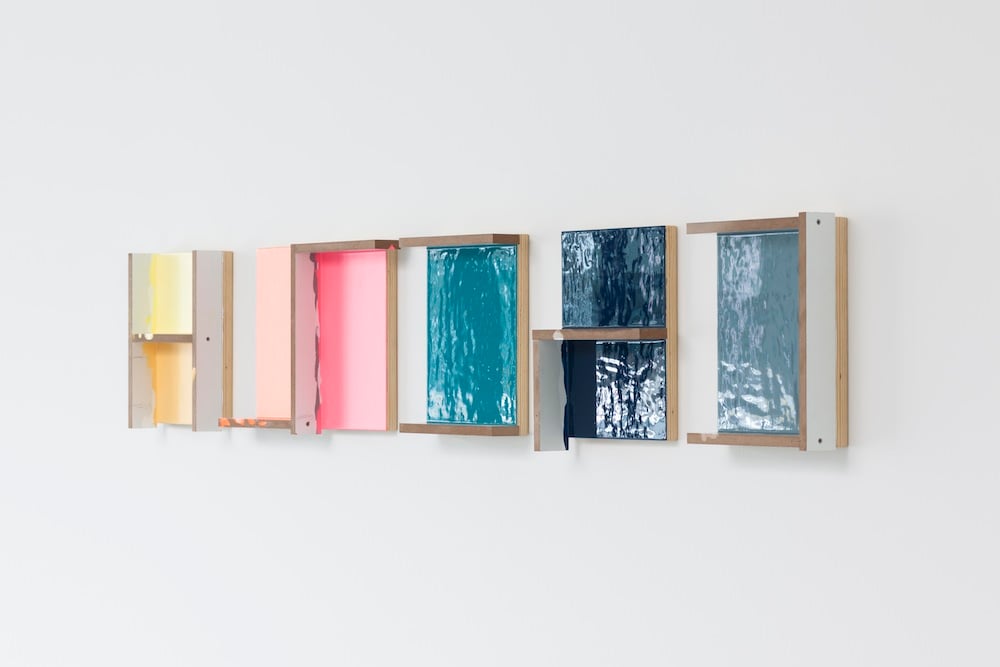
Underneath a black overhang with sleek white lettering reading VON BARTHA, the name of a venerable Basel family of art dealers, a woman fills her gas tank from one of two pumps. A sign lets drivers and passersby know that it’s €1.48 per liter.
Is this an art installation? Journalists are wondering. Cheeky, if so; but it’s actually just a working gas station. In the heart of Basel, Switzerland, it turns out, a contemporary art gallery can share space with a pit stop.
Galerie von Bartha, founded in 1970 by Margareta and Miklos von Bartha representing artists from the Zero movement, Concrete Art, and kinetic art, has called a repurposed garage space home since 2008, when the co-founders’ son Stefan took the directorial reins. Renovated by architect Lucas Voellmy, it was, and to an extent still is, a cavernous white cube space.
Yesterday, January 12, the gallery re-launched in the same location, with a second renovation by Voellmy that responded to the needs of the growing gallery, which is now expanding its scope to include a more international and emerging roster.
Making the light-filled gallery itself slightly more modest, there’s something for everyone with the new configuration: The gallery gets more storage space, which its artists can also use to prepare works before installation. A new and improved showroom will hopefully woo collectors, and for everyone else, a library composed of 4,500 books—47 years of gallery history—is open to the public, inviting students and art lovers alike to spend time in the reading room.
View of Ricardo Alcaide at von Bartha, Basel. Photo by Andreas Zimmerman, courtesy von Bartha Gallery.
The inaugural exhibition went to Sao Paolo-based artist Ricardo Alcaide, a new artist with the gallery, who is fascinated by built and urban environments, barriers and blockages, creation and destruction.
A series of black and white paintings on medium-density fiberboard panels are created by painting over a built structure, then removing the barriers when the shiny black pigment is dry to create geometric patterns inspired by Modernist architecture, like that of Oscar Niemeyer or Gio Ponti.
View of Ricardo Alcaide at von Bartha, Basel. Photo by Andreas Zimmerman, courtesy von Bartha Gallery.
Quite literally “concrete art,” two series of poured concrete panels hang on the wall, one set in black and white, the other, a Miami-inspired rainbow. A Carl Andre-like brick installation requires visitors to walk over rows of thin bricks, sourced from Spain, coated in black paint, to get to the bulk of the show.
The grand centerpiece is a large industrial shelving unit, populated with bronze casts of found objects from urban environments: crumpled paper, detritus, and another brick, this time from Brazil. Alcaide tells artnet News he is fascinated by bricks—who knew they were different in every country?
Alcaide met von Bartha barely a year ago, but he already fits well within its familial structure. He’s not the only new artist to join the team: the Santiago-born, New York-based Felipe Mujica, who works with flag-like textiles, also joined this year. As did Marianne Eigenheer, a Basel- and London-based artist whose primary medium is drawing (she always returns to the line, she tells artnet News).
The gallery is truly a family affair, not to mention that Stefan lives, with his obsessive art collection, in an apartment directly above. Basel is a welcoming home for von Bartha artists, and not just in June for Art Basel. Most of the international art world does not take the time to descend upon the city at the border of Switzerland, France, and Germany at the tail end of a snowstorm, as cranes remove Christmas trees from public squares.
But, as von Bartha tells artnet News in the brand-new showroom, surrounded by work by Eigenheer, Imi Knoebel, and Zero artist Adolf Luther, no matter the time of year, “It’s quite easy to spend the day in Basel looking at art.”
View of Ricardo Alcaide at von Bartha. Photo by Andreas Zimmerman, courtesy von Bartha Gallery.
“Of course Art Basel is when everyone is in town; that will always remain the most important time of the year,” he explains. But there’s a strong collector base in the city, and with just one hour by train to Zürich, and two to Geneva, it’s easy for Swiss collectors to make short trips to Basel to visit its institutions—from the three buildings of the Kunstmuseum, to the Kunsthalle down the road; or the Museum Tinguely, dedicated to Basel’s treasured kinetic artist, and the renowned Fondation Beyeler a bit north, all together nurturing an under-the-radar, but robust, scene.
“Every time the Fondation Beyeler or the Kunstmuseum has an opening, we have a lot of international collectors that come by,” von Bartha says. “If Fondation Beyeler does something, we are very happy.”
But von Bartha’s re-launch proves there is ever more reason to visit Basel than just the big events.